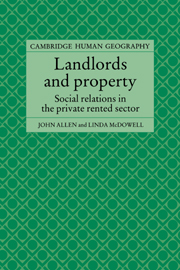Book contents
- Frontmatter
- Contents
- List of figures and tables
- Preface
- 1 Introduction
- 2 Private landlords: the anatomy of uneven decline
- 3 The structure of private landlordism
- 4 Research design and methods
- 5 Landlords in profile: an intensive survey
- 6 Landlords in the inner city: an extensive survey
- 7 Political ideologies and private rental policies
- Policy postscript
- Appendix 1 Selecting the landlord sample from housing waiting list records
- Appendix 2 Who was rehoused?
- References
- Index
Appendix 2 - Who was rehoused?
Published online by Cambridge University Press: 17 September 2009
- Frontmatter
- Contents
- List of figures and tables
- Preface
- 1 Introduction
- 2 Private landlords: the anatomy of uneven decline
- 3 The structure of private landlordism
- 4 Research design and methods
- 5 Landlords in profile: an intensive survey
- 6 Landlords in the inner city: an extensive survey
- 7 Political ideologies and private rental policies
- Policy postscript
- Appendix 1 Selecting the landlord sample from housing waiting list records
- Appendix 2 Who was rehoused?
- References
- Index
Summary
Who were the 235 households in Hackney and the 302 in Islington who eventually gained enough points to rise to the top of the exceedingly long waiting lists in these inner city boroughs? Some of them had been registered on the waiting list for appallingly long periods, in one case almost fifty years, others for a few months only. Not surprisingly, given the overall levels of housing need in these two boroughs, the housing conditions of most applicants were appalling. The statistics in Table 1 delineate the general outlines of who lives in poor housing in the private rented sector in inner London. Colour and detail is added to the story by the case studies at the end of this appendix. The households in this sector of the housing market who eventually rise to the top of the housing waiting list are, in the main, people living in atrocious conditions of poverty. There are two main groups of people included in the samples. First, there is a group of what might be called residual or traditional tenants. These are very elderly households, single and married pensioners who have lived in the private rented sector all their lives. At the time at which they were setting up independent households, in the 1920s and 1930s mainly, the private landlord still housed the majority of British households.
- Type
- Chapter
- Information
- Landlords and PropertySocial Relations in the Private Rented Sector, pp. 194 - 197Publisher: Cambridge University PressPrint publication year: 1989



